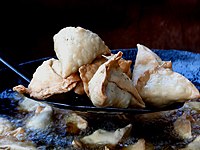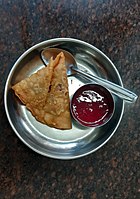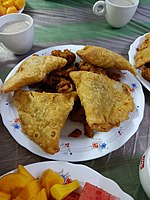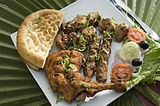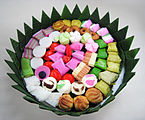Samosa/ja: Difference between revisions
Created page with "=== インド === <!--T:8--> サモサは薄力粉(現地ではマイダと呼ばれる)で作った生地に、さいの目に切って調理した、または茹でてつぶしたジャガイモ、タマネギ、グリーンピース、レンズマメ、ショウガ、香辛料、青唐辛子などを混ぜた具を詰めて作られる。具材によって、サモサは菜食の場合も非菜食の場合もある。全体をghee/ja|ギ..." Tags: Mobile edit Mobile web edit |
Created page with "== 類似の軽食 == サモサに似た軽食やその変種は他の多くの国でも見られる。それらは南アジアの{{lang|mis|somasa}}から派生したか、または中東に起源を持つ中世の前身から派生したものである。" |
||
| (15 intermediate revisions by 2 users not shown) | |||
| Line 36: | Line 36: | ||
サモサは[[all-purpose flour/ja|薄力粉]](現地ではマイダと呼ばれる)で作った生地に、さいの目に切って調理した、または茹でてつぶしたジャガイモ、タマネギ、グリーンピース、レンズマメ、ショウガ、香辛料、青唐辛子などを混ぜた具を詰めて作られる。具材によって、サモサは菜食の場合も非菜食の場合もある。全体を[[ghee/ja|ギー]]ではなく植物油で(まれにギーで)揚げ、黄金色になるまで[[deep-fried/ja|ディープフライ]]する。熱いうちに提供されることが多く、ミントや[[coriander/ja|コリアンダーチャツネ]]、[[tamarind/ja|タマリンドチャツネ]]などの新鮮なグリーンチャツネと共に供されることが多い。甘いタイプに作ることも可能である。サモサはよく紅茶とともに軽食として、あるいは伝統的な付け合わせ(ヒヨコマメまたは白エンドウの料理)にヨーグルト、タマリンドチャツネ、グリーンチャツネをかけ、刻んだタマネギ、コリアンダー、''[[chaat masala/ja|チャートマサラ]]''を添えた''[[chaat/ja|チャート]]''(屋台料理の一種)として提供される。 | サモサは[[all-purpose flour/ja|薄力粉]](現地ではマイダと呼ばれる)で作った生地に、さいの目に切って調理した、または茹でてつぶしたジャガイモ、タマネギ、グリーンピース、レンズマメ、ショウガ、香辛料、青唐辛子などを混ぜた具を詰めて作られる。具材によって、サモサは菜食の場合も非菜食の場合もある。全体を[[ghee/ja|ギー]]ではなく植物油で(まれにギーで)揚げ、黄金色になるまで[[deep-fried/ja|ディープフライ]]する。熱いうちに提供されることが多く、ミントや[[coriander/ja|コリアンダーチャツネ]]、[[tamarind/ja|タマリンドチャツネ]]などの新鮮なグリーンチャツネと共に供されることが多い。甘いタイプに作ることも可能である。サモサはよく紅茶とともに軽食として、あるいは伝統的な付け合わせ(ヒヨコマメまたは白エンドウの料理)にヨーグルト、タマリンドチャツネ、グリーンチャツネをかけ、刻んだタマネギ、コリアンダー、''[[chaat masala/ja|チャートマサラ]]''を添えた''[[chaat/ja|チャート]]''(屋台料理の一種)として提供される。 | ||
[[:en:Assam|アッサム州]]、[[:en:Odisha|オディシャ州]]、[[:en:West Bengal|西ベンガル州]]、[[:en:Bihar|ビハール州]]、および[[:en:Jharkhand|ジャールカンド州]]では、''singara''(সিঙ্গারা)または''shingra''({{lang|as|চিংৰা}})(東インド版サモサ)がほぼ至る所で見られる人気の軽食である。これらはインドの他地域のものよりやや小さく、具は主に調理したさいの目のジャガイモ、ピーナッツ、時にはレーズンから成る。''shingra''は(薄力粉で作った)薄い生地で包まれ、揚げられる。良い''shingra''は、塩味のパイ皮のようにサクサクした食感で見分けられる。 | |||
シンガラは紅茶とともに軽食として食べられることもある。また甘いタイプに作ることも可能である。ベンガルのシンガラは三角形で、ジャガイモ、エンドウ、タマネギ、刻んだアーモンド、その他の野菜を詰め、他のシンガラやサモサよりも強く揚げられ、よりカリカリしている。カリフラワーの混ぜ物を詰めたシンガラは人気のバリエーションである。非菜食のシンガラにはマトンシンガラやフィッシュシンガラがある。甘いバージョンとしてはココナッツシンガラや、''[[khoya/ja|コーヤ]]''を詰めて砂糖シロップに浸したものがあり、これはミシュティ・シンガラとして知られる。 | |||
[[:en:Hyderabad, India|ハイデラバード]]市では、厚めのペイストリー生地と刻んだ肉の具を詰めた小型のサモサが''[[lukhmi/ja|ルクミ]]''と呼ばれて食されており、タマネギの具を詰めたバリエーションもある。スパイシーなタマネギの具を詰めたクリスピーなサモサも市内で人気があり、イラニ/オニオンサモサとして知られる。これらは市内の[[Irani cafes/ja|イラニカフェ]]によって広められ、鉄道駅やバス停でも広く販売されている。 | |||
[[:en:Andhra Pradesh|アーンドラ・プラデーシュ州]]、[[:en:Karnataka|カルナータカ州]]、[[:en:Kerala|ケーララ州]]、[[:en:Tamil Nadu|タミル・ナードゥ州]]では、サモサは形や生地のスタイルがやや異なり、ポルトガルの{{lang|pt|chamuças}}に似た折り方をし、具材も異なる。具は一般に香辛料と混ぜたマッシュポテト、揚げたタマネギ、エンドウ、ニンジン、キャベツ、カレーリーフ、青唐辛子で、チャツネを添えずに食べられることが多い。[[:en:South India|南インド]]のサモサはサイズも様々で、具は地域の食習慣に影響され、肉を含む場合もある。 | |||
<gallery widths="200" heights="200"> | <gallery widths="200" heights="200"> | ||
File:Samosas before being fried.jpg| | File:Samosas before being fried.jpg|[[Kolkata|コルカタ]]の菓子店で揚げられる前のサモサ | ||
File:Samosasindia.jpg| | File:Samosasindia.jpg|インドのサモサ | ||
File:Samosa with sauce available at Indian Coffee Houses in Kerala .jpg| | File:Samosa with sauce available at Indian Coffee Houses in Kerala .jpg|ケーララ州のインドコーヒーハウスで供されるトマトケチャップ付きサモサ | ||
File:Vegetable Samosa.jpg| | File:Vegetable Samosa.jpg|野菜サモサ | ||
File:Samoosa.jpg| | File:Samoosa.jpg|野菜サモサ | ||
</gallery> | </gallery> | ||
=== バングラデシュ === | |||
[[File:Samosas, snack food at Wikipedia’s 16th Birthday celebration in Chittagong (01).jpg|thumb|バングラデシュのサモサ(軽食)]] | |||
[[File:Samosas, snack food at | |||
平らな形(三角形)と完全な形(四面体/三角錐)のサモサが、バングラデシュでは人気のスナックである。完全な形のサモサのベンガル語版は「{{lang|bn|সিঙাড়া}}」({{transliteration|bn|shingara}})と呼ばれ、標準的なサイズより小さいことが多い。{{transliteration|bn|shingara}} には通常、刻んだジャガイモ、野菜、ナッツなどが詰められるが、国の一部地域では牛レバー入りの{{transliteration|bn|shingara}}が特に人気です。平らな形のサモサは「{{transliteration|bn|somosa}}」または「{{transliteration|bn|somucha}}」と呼ばれ、通常はタマネギとひき肉が詰められる。 | |||
=== ネパール === | |||
=== Nepal | [[:en:Nepal|ネパール]]東部では、サモサは「{{transliteration|ne|singadas}}」と呼ばれ、それ以外の地域では「サモサ」と呼ばれる。ネパールには、インドから移住してきた商人やコミュニティ(例えば[[:en:Marwari people|マールワーリー族]])によってサモサがもたらされ、すぐに人気のスナックとなった。近隣諸国のようにチャツネと一緒に食べるのではなく、ネパールではひよこ豆やグリーンピースのカレー風スープと一緒に提供・消費されることが多い。屋台やレストランで広く販売されている。 | ||
=== パキスタン === | |||
[[:en:Pakistan|パキスタン]]全土でさまざまな種類のサモサが販売されている。一般的に、南部の[[:en:Sindh|シンド州]]や東部の[[:en:Punjab (Pakistan)|パンジャーブ州]](特に[[:en:Lahore|ラホール]]市)で売られるサモサはよりスパイシーで、主に野菜やジャガイモをベースにした具が入っている。一方、西部や北部で売られるサモサは、比較的スパイスが控えめで、ひき肉(ラム肉、牛肉、鶏肉)が主な具材である。肉入りサモサはパキスタンで人気のスナックである。 | |||
パキスタンの[[:en:Karachi|カラチ]]のサモサは辛い味付けで有名で、[[:en:Faisalabad|ファイサラーバード]]のサモサは特に大きいことで知られている。カラチで販売されるもう一つの独特なサモサは「{{transliteration|ur|kaghazi samosa}}」({{langx|ur|{{nq|کاغذی سموسہ}}}}、英語で「ペーパーサモサ」)と呼ばれ、薄くてパリパリの皮が特徴で、見た目や食感がワンタンや春巻きの皮に似ている。パンジャーブでは、サモサをマッシュしたスパイス入りひよこ豆、タマネギ、コリアンダーの葉サラダと一緒に食べたり、各種チャツネをかけて食べるスタイルもある。ペシャーワルを含むパキスタンの都市では甘いサモサも販売されており、中身がなく濃い砂糖シロップに浸されている。 | |||
パキスタンのパンジャーブ地方では「{{transliteration|ur|samosa chaat}}」というスナックも人気があります。これは、砕いたサモサにスパイス入りひよこ豆([[Chaat/ja|チャナチャート]])、ヨーグルト、チャツネを組み合わせたものである。もちろん、サモサはチャツネを添えてそのまま食べることもできる。 | |||
パキスタンでは、サモサはラマダーン([[:en:Ramadan|ラマザン]])の期間中、多くの家庭の定番[[iftar/ja|イフタール]](断食明けの食事)料理である。 | |||
=== モルディブ === | |||
[[Maldivian cuisine/ja|モルディブ料理]]で作られるサモサは「{{transliteration|dv|bajiyaa}}」と呼ばれる。ツナなどの魚とタマネギを混ぜた具材が詰められている。 | |||
== 類似の軽食 == | |||
= | サモサに似た軽食やその変種は他の多くの国でも見られる。それらは南アジアの{{lang|mis|somasa}}から派生したか、または中東に起源を持つ中世の前身から派生したものである。 | ||
<div lang="en" dir="ltr" class="mw-content-ltr"> | <div lang="en" dir="ltr" class="mw-content-ltr"> | ||
Latest revision as of 14:25, 10 August 2025
| サモサ | |
|---|---|
 チャツネを添えたサモサ | |
| 別名 | サンブーサ、サムーサ、シンガラ、シンガラ/シンガラ、サモーサ |
| 種類 | セイボリー・ペイストリー |
| フルコース | オードブル、付け合わせ、スナック菓子 |
| 地域 | 南アジア、西アジア、東アフリカ、中央アジア、東南アジア |
| 提供時温度 | 熱い |
| 主な材料 | 小麦粉、野菜(ジャガイモ、タマネギ、エンドウ豆、レンズ豆など)、香辛料、トウガラシ、挽き肉、チーズ |
サモサ (/səˈmoʊsə/) (![]() listen (help·info)) (ヒンディー語: समोसा) (ペルシア語: سمبوسه) は、揚げた南アジアおよび西アジアの軽食である。ペイストリー生地に香辛料で味付けされたジャガイモ、タマネギ、エンドウなどの野菜を詰めるのが一般的であるが、肉や魚、さらにはチーズを含む場合もある。その名称は中世ペルシア語の sambosag (سنبوسگ)(「三角形のペイストリー」の意)に由来する。地域によって三角形、円錐形、三日月形など様々な形で作られる。サモサはしばしばチャツネとともに提供され、その起源は中世あるいはそれ以前に遡る。甘いバージョンも作られる。サモサは南アジア、東南アジア、西アジア、中央アジア、ポルトガル、東アフリカおよびそれらの南アジア系ディアスポラの料理において人気のある前菜、アペタイザー、またはスナックである。
listen (help·info)) (ヒンディー語: समोसा) (ペルシア語: سمبوسه) は、揚げた南アジアおよび西アジアの軽食である。ペイストリー生地に香辛料で味付けされたジャガイモ、タマネギ、エンドウなどの野菜を詰めるのが一般的であるが、肉や魚、さらにはチーズを含む場合もある。その名称は中世ペルシア語の sambosag (سنبوسگ)(「三角形のペイストリー」の意)に由来する。地域によって三角形、円錐形、三日月形など様々な形で作られる。サモサはしばしばチャツネとともに提供され、その起源は中世あるいはそれ以前に遡る。甘いバージョンも作られる。サモサは南アジア、東南アジア、西アジア、中央アジア、ポルトガル、東アフリカおよびそれらの南アジア系ディアスポラの料理において人気のある前菜、アペタイザー、またはスナックである。
語源
英語の samosa は、ヒンスターニー語の samosa (Urdu: سموسہ, Hindi: समोसा) に由来し、さらに遡ると中世ペルシア語の sambōsag (سنبوسگ)(「三角形のペイストリー」)に行き着く。類似のペイストリーは、アラビア語ではsambusakと呼ばれ、これはペルシア語からの借用である。中世アラビア語の料理書では、sambusajと綴られる場合もあり、いずれもペルシア語の sanbosag から借用されたものである。
歴史


南アジアのサモサは、中東における焼かれたもので揚げられていない中世の原型から派生したと考えられている。サモサの原型についての最古の言及は、アッバース朝時代の詩人Ishaq al-Mawsiliによるもので、sanbusaj を称賛している。10世紀から13世紀のアラブ料理書には、sanbusak、sanbusaq、sanbusaj の名でレシピが記されており、いずれもペルシア語の sanbosag に由来する。イランでは16世紀まで広く人気があったが、20世紀までにはその人気は特定の州(ラーレスターンのsambusasなど)に限定されるようになった。Abolfazl Beyhaqi(995年–1077年)というイラン人の歴史家は、自身の著作『Tarikh-e Beyhaghi』の中でこれについて言及している。
中央アジアの サムサ は、13世紀または14世紀に中東や中央アジアから来た料理人によってインド亜大陸にもたらされた。彼らはデリー・スルターン朝の支配者の宮廷厨房で働いていた。学者でありデリー・スルターン朝の宮廷詩人であったAmir Khusro(1253年–1325年)は、1300年頃に王族や貴族が「肉、ギー、タマネギなどで作られたサモサ」を好んで食べていたと記している。14世紀の旅行家・探検家であるIbn Battutaは、Muhammad bin Tughluqの宮廷での食事について記し、そこで供された samushak または sambusak を、小さなパイで、中に刻んだ肉、アーモンド、ピスタチオ、クルミ、香辛料が詰められたものであり、これは プラオ の3品目の前に出されていたと述べている。中央インドのマールワー・スルターン朝の支配者Ghiyath Shahのために編まれた中世インドの料理書『Nimatnama-i-Nasiruddin-Shahi』にもサモサ作りの技術が記されている。16世紀のムガル帝国の文献『Ain-i-Akbari』にはコッタブのレシピが記されており、その中で「ヒンドゥスターンの人々はこれを sanbúsah と呼ぶ」としている。
サモサはその塩味の風味と便利さによって人気を得た。ポケットサイズのこの食品は、中央アジアや南アジア各地の労働者や旅行者にとって手軽に入手できる軽食であった。
地域別の種類
インド
サモサは薄力粉(現地ではマイダと呼ばれる)で作った生地に、さいの目に切って調理した、または茹でてつぶしたジャガイモ、タマネギ、グリーンピース、レンズマメ、ショウガ、香辛料、青唐辛子などを混ぜた具を詰めて作られる。具材によって、サモサは菜食の場合も非菜食の場合もある。全体をギーではなく植物油で(まれにギーで)揚げ、黄金色になるまでディープフライする。熱いうちに提供されることが多く、ミントやコリアンダーチャツネ、タマリンドチャツネなどの新鮮なグリーンチャツネと共に供されることが多い。甘いタイプに作ることも可能である。サモサはよく紅茶とともに軽食として、あるいは伝統的な付け合わせ(ヒヨコマメまたは白エンドウの料理)にヨーグルト、タマリンドチャツネ、グリーンチャツネをかけ、刻んだタマネギ、コリアンダー、チャートマサラを添えたチャート(屋台料理の一種)として提供される。
アッサム州、オディシャ州、西ベンガル州、ビハール州、およびジャールカンド州では、singara(সিঙ্গারা)またはshingra(চিংৰা)(東インド版サモサ)がほぼ至る所で見られる人気の軽食である。これらはインドの他地域のものよりやや小さく、具は主に調理したさいの目のジャガイモ、ピーナッツ、時にはレーズンから成る。shingraは(薄力粉で作った)薄い生地で包まれ、揚げられる。良いshingraは、塩味のパイ皮のようにサクサクした食感で見分けられる。
シンガラは紅茶とともに軽食として食べられることもある。また甘いタイプに作ることも可能である。ベンガルのシンガラは三角形で、ジャガイモ、エンドウ、タマネギ、刻んだアーモンド、その他の野菜を詰め、他のシンガラやサモサよりも強く揚げられ、よりカリカリしている。カリフラワーの混ぜ物を詰めたシンガラは人気のバリエーションである。非菜食のシンガラにはマトンシンガラやフィッシュシンガラがある。甘いバージョンとしてはココナッツシンガラや、コーヤを詰めて砂糖シロップに浸したものがあり、これはミシュティ・シンガラとして知られる。
ハイデラバード市では、厚めのペイストリー生地と刻んだ肉の具を詰めた小型のサモサがルクミと呼ばれて食されており、タマネギの具を詰めたバリエーションもある。スパイシーなタマネギの具を詰めたクリスピーなサモサも市内で人気があり、イラニ/オニオンサモサとして知られる。これらは市内のイラニカフェによって広められ、鉄道駅やバス停でも広く販売されている。
アーンドラ・プラデーシュ州、カルナータカ州、ケーララ州、タミル・ナードゥ州では、サモサは形や生地のスタイルがやや異なり、ポルトガルのchamuçasに似た折り方をし、具材も異なる。具は一般に香辛料と混ぜたマッシュポテト、揚げたタマネギ、エンドウ、ニンジン、キャベツ、カレーリーフ、青唐辛子で、チャツネを添えずに食べられることが多い。南インドのサモサはサイズも様々で、具は地域の食習慣に影響され、肉を含む場合もある。
-
コルカタの菓子店で揚げられる前のサモサ
-
インドのサモサ
-
ケーララ州のインドコーヒーハウスで供されるトマトケチャップ付きサモサ
-
野菜サモサ
-
野菜サモサ
バングラデシュ
平らな形(三角形)と完全な形(四面体/三角錐)のサモサが、バングラデシュでは人気のスナックである。完全な形のサモサのベンガル語版は「সিঙাড়া」(shingara)と呼ばれ、標準的なサイズより小さいことが多い。shingara には通常、刻んだジャガイモ、野菜、ナッツなどが詰められるが、国の一部地域では牛レバー入りのshingaraが特に人気です。平らな形のサモサは「somosa」または「somucha」と呼ばれ、通常はタマネギとひき肉が詰められる。
ネパール
ネパール東部では、サモサは「singadas」と呼ばれ、それ以外の地域では「サモサ」と呼ばれる。ネパールには、インドから移住してきた商人やコミュニティ(例えばマールワーリー族)によってサモサがもたらされ、すぐに人気のスナックとなった。近隣諸国のようにチャツネと一緒に食べるのではなく、ネパールではひよこ豆やグリーンピースのカレー風スープと一緒に提供・消費されることが多い。屋台やレストランで広く販売されている。
パキスタン
パキスタン全土でさまざまな種類のサモサが販売されている。一般的に、南部のシンド州や東部のパンジャーブ州(特にラホール市)で売られるサモサはよりスパイシーで、主に野菜やジャガイモをベースにした具が入っている。一方、西部や北部で売られるサモサは、比較的スパイスが控えめで、ひき肉(ラム肉、牛肉、鶏肉)が主な具材である。肉入りサモサはパキスタンで人気のスナックである。
パキスタンのカラチのサモサは辛い味付けで有名で、ファイサラーバードのサモサは特に大きいことで知られている。カラチで販売されるもう一つの独特なサモサは「kaghazi samosa」(Urdu: کاغذی سموسہ、英語で「ペーパーサモサ」)と呼ばれ、薄くてパリパリの皮が特徴で、見た目や食感がワンタンや春巻きの皮に似ている。パンジャーブでは、サモサをマッシュしたスパイス入りひよこ豆、タマネギ、コリアンダーの葉サラダと一緒に食べたり、各種チャツネをかけて食べるスタイルもある。ペシャーワルを含むパキスタンの都市では甘いサモサも販売されており、中身がなく濃い砂糖シロップに浸されている。
パキスタンのパンジャーブ地方では「samosa chaat」というスナックも人気があります。これは、砕いたサモサにスパイス入りひよこ豆(チャナチャート)、ヨーグルト、チャツネを組み合わせたものである。もちろん、サモサはチャツネを添えてそのまま食べることもできる。
パキスタンでは、サモサはラマダーン(ラマザン)の期間中、多くの家庭の定番イフタール(断食明けの食事)料理である。
モルディブ
モルディブ料理で作られるサモサは「bajiyaa」と呼ばれる。ツナなどの魚とタマネギを混ぜた具材が詰められている。
類似の軽食
サモサに似た軽食やその変種は他の多くの国でも見られる。それらは南アジアのsomasaから派生したか、または中東に起源を持つ中世の前身から派生したものである。
Central Asia
The samsa is a savoury pastry in Central Asian cuisines, consisting of a bun stuffed with meat and sometimes vegetables.
Southeast Asia
Myanmar (Burma)

Samosas are called samuza (စမူဆာ) in Burmese, and are an extremely popular street snack in Burma. Samosas are also used in a traditional Burmese salad called samuza thoke (စမူဆာသုပ်; lit. 'samosa salad'), a salad of cut samosa pieces with onions, cabbage, fresh mint, light potato and chickpea curry broth, masala, chili powder, salt and lime.
Indonesia

In Indonesia, samosas are locally known as samosa, filled with potato, cheese, curry, rousong or noodles as adapted to local taste. They are usually served as a snack with sambal. Samosa is similar to Indonesian pastel, panada and epok-epok.
Africa
East Africa
Samosas are also a key part of East African food often seen in Somalia, Tanzania, Kenya, Uganda, Burundi, Eritrea, Ethiopia, and Rwanda. In much of East Africa, samosa is called "sambusa" (Tigrinya and Amharic: ሳምቡሳ "sāmbusā," Somali: sambuus, Swahili: sambusa, Arabic: سمبوسة "sambusa")
Samosas, locally called samoussas, are a popular snack on Réunion and Mauritius as both islands have faced large waves of labor immigration from the Indian subcontinent. The samosas there are generally smaller and filled with chicken, cheese, crabs or potatoes. There are also varieties such as chocolate and banana or pizza.
The variety of samosa made in Somali cuisine is filled with ground beef or vegetables, along with usually being blended with Somali spices. Sambusa is often consumed during Ramadan. Samosas are also a staple of local cuisine in the fellow Horn of Africa countries of Djibouti and Ethiopia.

South Africa
Called samoosas in South Africa, they tend to be smaller than Indian variants, and form part of South African Indian and Cape Malay cuisine.
West Africa
Samosas also exist in West African countries such as Ghana and Nigeria, where they are a common street food. In Nigeria, it is usually served in parties along with chicken or beef, puff puff, spring rolls and plantains and are called small chops.
Middle East
Arab countries

Sambousek (Arabic: سمبوسك) are usually filled with either meat, onion, pine nuts, za’atar, spinach dock, or cheese.
Iran

Sambuseh (Persian: سمبوسه) can often be found in the southern regions of Iran and rarely in other areas. However, traditionally it used to be made in the form of qottab filled with ground nuts (usually, walnuts), sugar, fragrant herbs or spices, and likewise fried in oil. It is used as a confectionary and quite commonly. When meat is used, it is no longer called qottab. This is all that remains of the old "sanbusag" in its ancient homeland. Nowadays, Iranian Sambuseh is often made with a sausage and pizza cheese based filling; however, a vegetable-based variety also exists.
Israel
Sambusak (Hebrew: סמבוסק) comes in several distinct forms, as sambusak has been influenced differently by Sephardic and Mizrahi cuisine. Sephardi sambusak is generally thicker, baked, and stuffed with either cheese or beef and coated with sesame or nigella seeds. Mizrahi sambusak is generally thinner, larger, fried, and stuffed with curry-spiced chickpea and onion, and is usually not coated with seeds.
Portuguese-speaking regions
In Goa (India), Portugal, and Angola, samosas are known as chamuças. They are usually filled with chicken, beef, pork, lamb or vegetables, and generally served quite hot. Samosas are an integral part of Goan and Portuguese cuisine, where they are a common snack.
-
Goan chamuças
-
Portuguese chamuças in a café in Ponta Delgada
-
Angolan chamuças
English-speaking regions
Samosas are popular in the United Kingdom, Australia, New Zealand, Trinidad and Tobago, Barbados, Guyana, Uganda, South Africa, Rwanda, Kenya and Tanzania, and are also growing in popularity in Canada and the United States. They may be called samboosa or sambusac, but in South Africa, they are often called samoosa. Frozen samosas are increasingly available from grocery stores in Australia, Canada, the United States, and the United Kingdom, where they are also frequently sold fresh by local Indian and Pakistani street market vendors.
Al-Shabaab's samosa ban
Al-Shabaab, the extremist group controlling parts of Somalia, banned samosas in 2011 over concerns about the possible use of rotten meat in the filling.
関連項目
外部リンク
| この記事は、クリエイティブ・コモンズ・表示・継承ライセンス3.0のもとで公表されたウィキペディアの項目Samosa(2 August 2025, at 05:13編集記事参照)を翻訳して二次利用しています。 |
- Pages with broken file links
- Pastries
- Central Asian cuisine
- Bangladeshi fast food
- Bangladeshi snack foods
- Indian snack foods
- Indonesian snack foods
- Middle Eastern cuisine
- Sephardi Jewish cuisine
- Stuffed dishes
- Kashmiri cuisine
- Burmese cuisine
- Goan cuisine
- Pakistani fast food
- Pakistani snack foods
- Indian fast food
- Somali cuisine
- Maldivian cuisine
- Malaysian cuisine
- Singaporean cuisine
- Nepalese cuisine
- Portuguese cuisine
- Cuisine of Odisha
- Iranian pastries
- South African cuisine
- Eritrean cuisine
- Ethiopian cuisine
- Kenyan cuisine
- Djiboutian cuisine
- Deep fried foods
- Tajik cuisine
- South Asian cuisine
- North Indian cuisine
- South Indian cuisine
- Dumplings
- Arab pastries
- Bangladeshi cuisine
- Pakistani cuisine
- Indo-Caribbean cuisine
- Barbadian cuisine
- Fijian cuisine
- Israeli pastries

